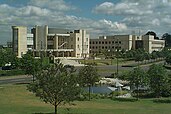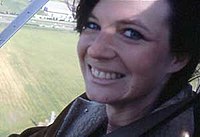Portal:Aviation
| Main page | Categories & Main topics |
|
Tasks and Projects |
The Aviation Portal

Aviation includes the activities surrounding mechanical flight and the aircraft industry. Aircraft includes fixed-wing and rotary-wing types, morphable wings, wing-less lifting bodies, as well as lighter-than-air craft such as hot air balloons and airships.
Aviation began in the 18th century with the development of the hot air balloon, an apparatus capable of atmospheric displacement through buoyancy. Some of the most significant advancements in aviation technology came with the controlled gliding flying of Otto Lilienthal in 1896; then a large step in significance came with the construction of the first powered airplane by the Wright brothers in the early 1900s. Since that time, aviation has been technologically revolutionized by the introduction of the jet which permitted a major form of transport throughout the world. (Full article...)
Selected article
Selected image

Did you know

...that the Fokker Spin (pictured) was the first aircraft built by Anthony Fokker, in which he taught himself to fly and earned his pilot license? ...that the airfields captured in the battle of Tinian were used for the atomic bombings of Hiroshima and Nagasaki? ... that the first exhibition at the Boeing Galleries was a series of photographs taken from helicopters and hot air balloons?
General images -
In the news
- May 29: Austrian Airlines cancels Moscow-bound flight after Russia refuses a reroute outside Belarusian airspace
- August 8: Passenger flight crashes upon landing at Calicut airport in India
- June 4: Power firm helicopter strikes cables, crashes near Fairfield, California
- January 29: Former basketball player Kobe Bryant dies in helicopter crash, aged 41
- January 13: Iran admits downing Ukrainian jet, cites 'human error'
- January 10: Fire erupts in parking structure at Sola Airport, Norway
- October 27: US announces restrictions on flying to Cuba
- October 3: World War II era plane crashes in Connecticut, US, killing at least seven
- September 10: Nevada prop plane crash near Las Vegas leaves two dead, three injured
- August 6: French inventor Franky Zapata successfully crosses English Channel on jet-powered hoverboard
Related portals
Associated Wikimedia
The following Wikimedia Foundation sister projects provide more on this subject:
-
Commons
Free media repository -
Wikibooks
Free textbooks and manuals -
Wikidata
Free knowledge base -
Wikinews
Free-content news -
Wikiquote
Collection of quotations -
Wikisource
Free-content library -
Wikiversity
Free learning tools -
Wikivoyage
Free travel guide -
Wiktionary
Dictionary and thesaurus
Selected biography
Despite her surname, Jeana Yeager is not related to Chuck Yeager, the first man to break the sound barrier in level flight.
Selected Aircraft

The Yakovlev Yak-42 is a line of tri-jet aircraft produced by the aircraft company Yakolev. The Yak 42 was produced from 1980-2003.
Historically, the yak-42 was competition for older Russian aircraft companies. The Yak-42 was only made in one passenger variant, but it was used in many tests of equipment.
Today in Aviation
- 2013 – Nepal Airlines Flight 555, the de Havilland Canada DHC-6 Twin Otter 9N-ABO, skids off the runway at Jomsom Airport in Jomsom, Nepal, and falls 20 meters (65 feet) into the Gandaki River. All 21 people on board survive, but seven suffer serious injuries.
- 2011 – Launch: Space Shuttle Endeavour STS-134 at 12:56:28 UTC. Mission highlights: ISS assembly flight ULF6, ELC 3, ROEU, Alpha Magnetic Spectrometer. Final flight of Endeavour.
- 2001 – A Turkish Air Force CASA CN-235M-100 crashes into a field in Malatya, Turkey killing all 34 on board.
- 1995 – A Royal Air Force BAe Nimrod is forced to ditch in Moray Firth
- 1992 – STS-49, maiden flight of the Space Shuttle Endeavour lands at Edwards AFB.
- 1992 – Munich-Riem Airport, the main, international airport of Munich until is closed down. Operations moved to the new location near Freising. The IATA airport code MUC and the ICAO airport code EDDM were transferred to the new Munich Franz Josef Strauss Airport.
- 1992 – The 2,000th C-130 Hercules rolls off the production line.
- 1986 – Top Gun (film) opens in theaters in United States.
- 1977 – The landing gear failed on a New York Airways Sikorsky S-61 while it was taking on passengers on the roof of the Pan Am building. The aircraft rolled onto its side. Its spinning rotor blades killed four passengers waiting to board (including movie director Michael Findlay) and injured a fifth. Parts of a broken blade fell into the streets below, killing one pedestrian and injuring another.
- 1968 – A British Overseas Airways Corporation (BOAC) Super Vickers VC10 on a routine service from Chicago and Montreal makes the airline’s first fully automatic approach and landing in London.
- 1961 – First flight of Mikoyan/Gurevich Ye-152/1, Soviet single-seat fighter/interceptor aircraft.
- 1959 – Newly-formed RCAF aerobatic team, the Golden Hawks, flying gold-finished North American F-86 Sabre, performed its first demonstration at Torbay, Newfoundland.
- 1958 – Captain Walter W. Irwin sets a new airspeed record of 1,404 mph (2,259 km/h) in a F-104 Starfighter, the first record over 2,000 km/h.
- 1957 – First flight of the Saunders-Roe SR.53, prototype interceptor aircraft of mixed jet and rocket propulsion developed for the Royal Air Force.
- 1954 – Birth of Dafydd Rhys "Dave" Williams, Canadian physician and a retired CSA astronaut. He had two space flights, both of which were Space Shuttle missions.
- 1953 – 90 U. S. Air Force Republic F-84 Thunderjets carry out a successful attack against Chusan, Korea.
- 1946 – A B-17G Flying Fortress crashes into White's Hill near Fairfax, California, while en route to Hamilton Field in Marin County, California, after running out of fuel. Two crew members are killed.
- 1945 – Birth of Brewster Hopkinson Shaw, Jr. former NASA astronaut, veteran of three space shuttle missions and has logged 533 hours of space flight. He was pilot of Space Shuttle Columbia in November 1983, commander of Space Shuttle Atlantis in November 1985 and commander of Space Shuttle Columbia in August 1989.
- 1945 – (16-17) British Pacific Fleet carrier aircraft strike Japanese airfields in the Sakishima Gunto.
- 1943 – Launch of Operation Chastise, attack on German dams by Royal Air Force No. 617 Squadron, subsequently known as the "Dambusters", using a specially developed "bouncing bomb" invented and developed by Barnes Wallis.
- 1942 – Canadian Pacific Airlines was formed.
- 1940 – Death of Allen Benjamin Angus, DFC, Canadian WWII fighter pilot and first Canadian ace of WWII.
- 1930 – First flight of the Blériot Bl-110 nicknamed 'Joseph Le Brix', French high wing single engine monoplane prototype designed for endurance records.
- 1929 – Wings, a silent film about World War I fighter pilots, is the first film, and the only silent film ever, to win the Academy Award for Best Picture.
- 1920 – Birth of Joseph Otis Fletcher, American Air Force pilot and polar researcher, first pilot to land at the North Pole along with William Pershing Benedict with a Douglas C-47 Skytrain.
- 1919 – A naval Curtiss aircraft NC-4 commanded by Albert Cushing Read leaves Trepassey, Newfoundland, for Lisbon via the Azores on the first transatlantic flight.
- 1918 – The Imperial German Navy recommissions the light cruiser Stuttgart after her conversion into a seaplane carrier. She is the only German seagoing aviation ship capable of working with the fleet commissioned during either World War I or World War II.
- 1917 – Death of Enrico Cottino and Francesco Guadalupi in their Farman 14.
- 1915 – (16-17 overnight) Two Royal Naval Air Service Avro 504s interceot the Imperial German Navy Zeppelins LZ 38 and LZ 39, badly damaging LZ39 with four 20-lb (9-kg) bombs dropped on its envelope from above.
- 1890 – Birth of http://fr.wikipedia.org/wiki/Lucien_Bossoutrot, French pioneer aviator and politician.
References
- Shortcuts to this page: Portal:Airplanes • P:AVIA




















































